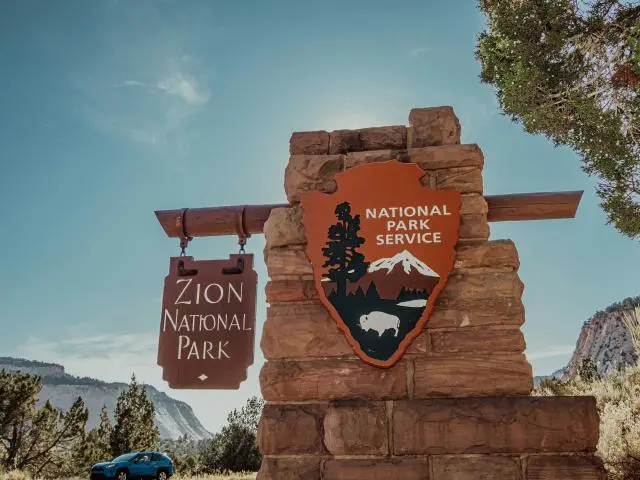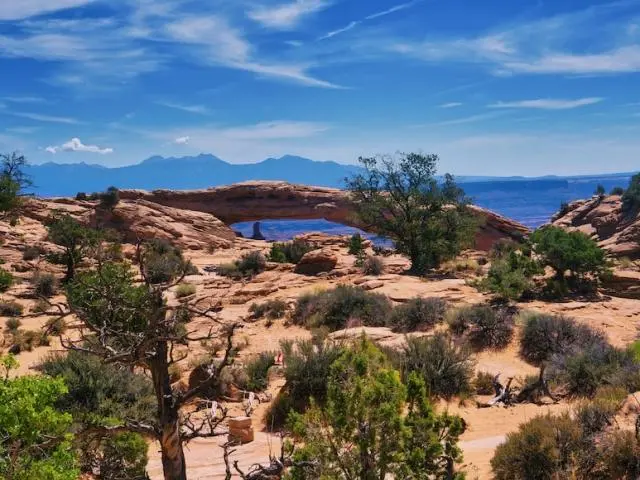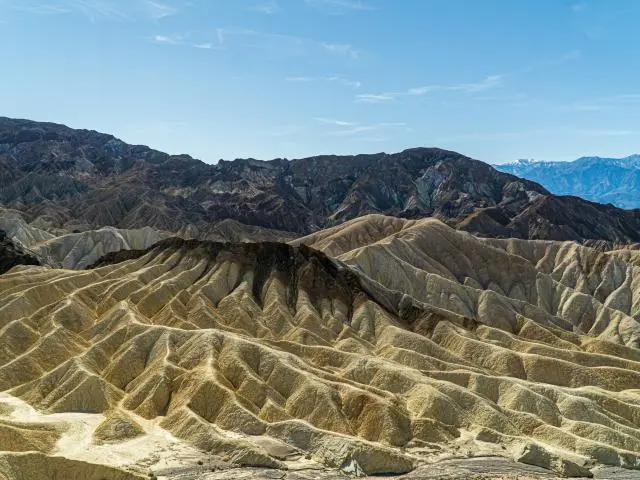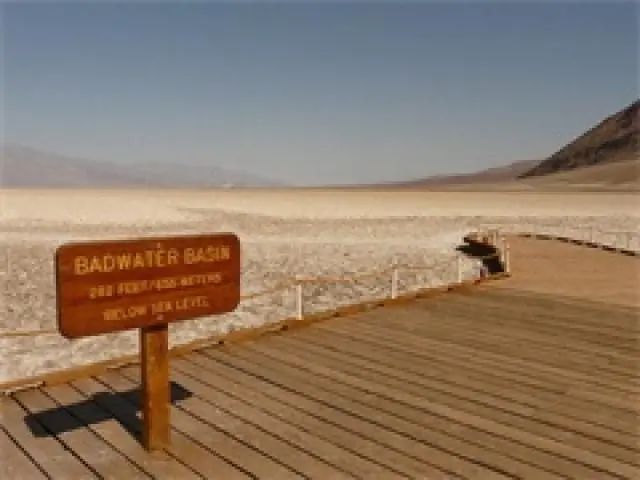Day 1 Las Vegas - Zion National Park (166 miles)
Day 2 Zion National Park - Bryce Canyon National Park (50 miles)
Day 3 Bryce Canyon National Park - Arches National Park - Canyonlands National Park (160 miles)
Day 4 Arches National Park - Canyonlands National Park
Day 5 Monument Valley (113 miles)
Day 6 Monument Valley - Grand Canyon South Rim (183 miles)
Day 7 Grand Canyon - Las Vegas (270 miles)
Day 8 Las Vegas - Death Valley - Bishop (248 miles)
Day 9 Bishop - Yosemite National Park (71 miles)
Day 10 Yosemite National Park
Day 11 Yosemite National Park - San Francisco (167 miles)
Day 1:
Las Vegas - Zion National Park (166 miles)
Leaving the bright lights of Las Vegas behind us for a while we head out to Utah's finest National Park -
Zion National Park. Massive canyon walls and red sandstone cliffs ascend toward a brilliant blue sky. Challenge yourself to what's considered the best half day hike in the southwest by hiking a narrow ridgeline to Angels Landing.
Take it easy exploring the pristine Emerald pools or enjoy a river hike deep in the narrows before enjoying a BBQ back at camp this evening.
-
Zion National Park, UT
Home to countless species of plants and animals, as well as breathtaking geological formations like the iconic "hoodoo" rock spires, Zion National Park in Utah is notable for its incredible desert terrain.
Day 2:
Zion National Park - Bryce Canyon National Park (50 miles)
A short drive today takes us to an elevation of 8000 ft into
Bryce National Park. Take a stroll along the rim and marvel at the unique sandstone spires (hoodoos) that rise dramatically from the natural amphitheater. Hike down into the hoodoos for an up close and personal experience with this fascinating landscape.
A soak in the outdoor hot tub back at camp will ease those hiking muscles and a night around the campfire will end this day nicely.
-
Bryce Canyon National Park, UT
The canyons of this national park form exquisite natural amphitheaters. Many visitors choose to sightsee by car, as the park is very easy to drive through.
Day 3:
Bryce Canyon National Park - Arches National Park - Canyonlands National Park (160 miles)
Explore this stunning landscape in a guided sunset hummer tour or hang of a sandstone cliff on one of our optional canyoneering adventures! Visit Arches National Park home to over 2000 arches for a hike up to Delicate Arch. Enjoy walks in Canyonlands National Park where the Green river meets the Colorado in some of the most spectacular scenery the southwest has to offer. Swap tales of Butch Cassidy and the Sundance Kid who used the canyons to hide from the law in the late 1800's, visit the local town and enjoy Utah's greatest adventure capital.
-
Arches National Park, UT
Arches National Park is home to the breathtaking scenery of natural stone arches, like the Delicate Arch and Fiery Furnace. It is close to Moab and Canyonlands National Park.
Delicate Arch
The most famous landmark in Utah's most famous park, this amazing red-sandstone natural arch is a longtime symbol of Arches National Park as well as the state of Utah. It has appeared on stamps, coins, and license plates.
-
Moab, UT
Moab is a city in Grand County, in eastern Utah, in the western United States. The population was 5,046 at the 2010 census. It is the county seat and largest city in Grand County. Moab attracts a large number of tourists every year, mostly visitors to the nearby Arches and Canyonlands National Parks.
Canyonlands National Park
The Colorado and Green Rivers have eroded the Utah landscape into a red-tinted world of impressive canyons, mesas, and buttes. Canyonlands National Park is separated into four distinct districts, the most popular of which is Island in the Sky.
Day 4:
Arches National Park - Canyonlands National Park
Today we will continue our exploration of Arches National Park and Canyonlands National Park.
Day 5:
Monument Valley (113 miles)
Headed south we wind out way through more of USA Southwest's spectacular scenery to one of the most iconic locations on the planet. The background for many famous western movies and home to the Navajo Indians you are in for a real treat today. Hop onboard a 4X4 jeep and enjoy an included Navajo guided tour of Monument Valley. Camp right along the rim, get ready to gaze up at the amazing starry skies and bag your front row seat to a magnificent sun rise.
-
Monument Valley Tribal Park, UT
In the midst of the vast desert, Monument Valley has been the setting for numerous movies over the years. The Tribal Park is a Navajo Indian reservation.
Day 6:
Monument Valley - Grand Canyon South Rim (183 miles)
Enjoy an optional visit to the world's most famous slot canyon - Antelope Canyon this morning followed by a scenic walk to view Horseshoe Bend before heading to the Grand Canyon. After a brief visit to a Navajo trading post we follow the mighty Colorado River through the painted desert to one of the seven natural wonders of the world!
Take in a bird's eye view on an optional helicopter ride, stroll along the rim at sunset, take a hike into the one of the deepest and most diverse canyons on earth or simply relax in one the rim cafes a admire the view before one last cookout and campfire.
-
Antelope Canyon, AZ
The most popular slot canyon in the American Southwest is Antelope Canyon, a sandstone formation formed by flood and rainwater. The canyon is located on a Navajo reservation, and has been made a Navajo Tribal Park.
Duration: Approx. 1 Hour 10 Minutes
-
Page, AZ
Page is a city in Coconino County, Arizona, United States, near the Glen Canyon Dam and Lake Powell. Page was founded in 1957 as a housing community for workers and their families during the construction of nearby Glen Canyon Dam on the Colorado River.
Horseshoe Bend
Horseshoe Bend, located within the Glen Canyon National Recreation Area about 5 miles downriver from Lake Powell, is a sharp turn in the Colorado River that formed from erosion over the course of millions of years.
Duration: Approx. 1 Hour
-
Grand Canyon, AZ
Considered one of the seven natural wonders of the world, the Grand Canyon was carved over 17 million years by the Colorado River. This breathtaking, 18-mile-long canyon has been stunning visitors for hundreds of years.
Duration: 2-3 Hours
Grand Canyon South Rim
The South Rim is the most popular of the Grand Canyon's rims, drawing in over five million visitors every year. It features the Grand Canyon Village area, which provides lodging and amenities to visitors.
Day 7:
Grand Canyon - Las Vegas (270 miles)
We get our kicks at Route 66 and arrive back in Sin City at approx 5pm
Day 8:
Las Vegas - Death Valley - Bishop (248 miles)
Heading to California this morning you will embark on a guided tour of Death Valley National Park. Enjoy photo stops and shorts walks at Zabriskie Point, Artist's Palette, Badwater BasinSalt flats, Furnace Creek Visitor Center, Devil's Golf Course and the Mesquite Sand Dunes. After a picnic lunch, drive through spectacular scenery to the old Gold Rush Historic town of Bishop for your night stop.
-
Death Valley, CA
Death Valley is a region of the Mojave Desert which has the distinction of being the lowest and driest area of North America. The hottest temperature ever recorded on Earth, occurred here.
Duration: 1-2 Hours
Zabriskie Point
Zabriskie Point is a part of Amargosa Range located east of Death
Valley in Death Valley National Park in California, United States, noted for
its erosional landscape. It is composed of sediments from Furnace Creek Lake,
which dried up 5 million years ago — long before Death Valley came into existence.
Artist's Palette
Tucked behind an unassuming yellow landscape, the rainbow of Artists Palette is the highlight along the Artists Drive Scenic Loop. Here, visitors marvel at an array of colors (red, orange, yellow, blue, pink, and green), splashed across the hills. These colors are from volcanic deposits rich in compounds such as iron oxides and chlorite, which creates a rainbow effect.
Badwater Basin
This barren basin in the heart of Death Valley National Park has an elevation of 282 feet below sea level, making it the lowest point in North America.
Golf Course of Devil
The Devil's Golf Course is a large salt pan on the floor of Death Valley. It was
named after a line in the 1934 National Park Service guide book to Death
Valley National Monument, which stated that "Only the devil could play golf"
on its surface, due to a rough texture from the large halite salt crystal formations.
Mesquite Flat Sand Dunes
The Mesquite Flat Sand Dunes are at the northern end of the valley floor and
are nearly surrounded by mountains on all sides. Due to their easy access from
the road and the overall proximity of Death Valley to Hollywood, these dunes
have been used to film sand dune scenes for several movies.
Day 9:
Bishop - Yosemite National Park (71 miles)
Crossing the Tioga Pass this morning provides an extremely scenic route passing by highlights such as Olmsted Point, Lake Tenaya, Tuolumne Meadows and Mono lake en route to Yosemite Valley. Visit the Valley Visitor Center and exhibits, take a mini tour and get ready for a full day of exploration tomorrow.
Weather permitting - in the event that the Tioga Pass is closed this tour will reroute through Lake lsabella instead of Bishop
-
Yosemite National Park, CA
Yosemite National Park in central California is best known for the amazing granite cliffs of the Yosemite Valley as well as the towering Yosemite Falls and Sequoias. Millions of people every year journey to this UNESCO World Heritage Site.
Olmsted Point (Passing By)
This scenic viewing area in Yosemite National Park offers a breathtaking view into Tenaya Canyon and the northern side of Half Dome. It is one of the park's most celebrated viewpoints.
Tenaya Lake (Passing By)
This alpine lake in Yosemite National Park sits at an elevation of 8,150 feet. It was formed over thousands of years by glacial activity against the local granite deposits.
Day 10:
Yosemite National Park
Spend a full day exploring the walks offered in the park. There are countless walks ranging from easy to strenuous or opt for a guided tour with your expert guide to the premierpanoramas within the park such as Bridalveil Falls, Lower Yosemite Falls, views of Half Dome and El Capitan. You can also opt for some free time relaxing or cycling along the Merced River.
-
Yosemite National Park, CA
Yosemite National Park in central California is best known for the amazing granite cliffs of the Yosemite Valley as well as the towering Yosemite Falls and Sequoias. Millions of people every year journey to this UNESCO World Heritage Site.
Bridal Veil Falls
Located in the Yosemite Valley California's Yosemite National Park, Bridal Veil Falls are one of the park's most famous sites. Millions of people every year come to see the 617-foot-high waterfall, which flows year-round.
Half Dome
The Half Dome is one of the most recognizable formations in California's Yosemite National Park. It is known the world over as a challenging and rewarding hiking and mountain climbing location, attracting thousands of adventurers every year.
Merced River
This 145-mile-long river flows from the Sierra Nevada down into California's Central Valley. Visitors to Yosemite National Park can hike along the river's banks or even go for a whitewater rafting trip down its rapids.
Yosemite Falls
The Yosemite Falls in Yosemite National Park, California are the highest known waterfall in all of North America. The Falls are on one of the park's most famous attractions, especially in the spring when they have the most water.
El Capitan
The largest granite monolith in the world, El Capitan is located across from Bridalveil Falls in Yosemite National Park. It juts up about 3,000 feet from the ground, and is a favorite of experienced rock climbers.
Day 11:
Yosemite National Park - San Francisco (167 miles)
In the morning we will leave Yosemite and drive to San Francisco, CA. Here, we will visit some of the city's most famous landmarks, including the Fisherman's Wharf, Pier 39, Haigh Ashbury and the Golden Gate Bridge.
-
San Francisco, CA
San Francisco, the heart of central California's Bay Area, is famous for its iconic Golden Gate Bridge, its unique culture, and its position at the forefront of technological innovation. Beautiful weather and waterfront views await visitors as well!
Fisherman's Wharf
This San Francisco neighborhood is a popular tourist area due to its lovely scenery and abundance of shops, restaurants, museums, and other attractions. The area also hosts several annual events, such as a July 4th fireworks show.
Golden Gate Bridge
The iconic arches of San Francisco, California's Golden Gate Bridge are known the world over as a symbol of California and the San Francisco Bay area. From movies to postcards, the Golden Gate Bridge is an American icon.

























 10-Day National Park Explorer Tour Grand Canyon, Yellowstone, ...
10-Day National Park Explorer Tour Grand Canyon, Yellowstone, ...
 9-Day Yellowstone, Grand Teton, Antelope & Tahoe from LA/Vegas...
9-Day Yellowstone, Grand Teton, Antelope & Tahoe from LA/Vegas...
 9-Day Yellowstone, Mount Rushmore, Grand Teton, Antelope Canyo...
9-Day Yellowstone, Mount Rushmore, Grand Teton, Antelope Canyo...
 10-Day Yellowstone, Mount Rushmore, Grand Teton, Antelope Cany...
10-Day Yellowstone, Mount Rushmore, Grand Teton, Antelope Cany...
 9-Day Yellowstone National Park, Antelope Canyon, Monument Val...
9-Day Yellowstone National Park, Antelope Canyon, Monument Val...